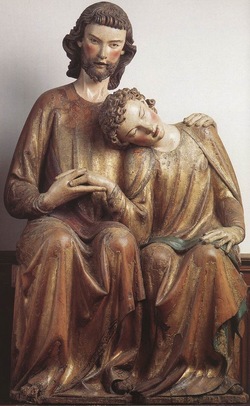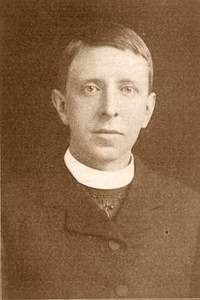Sacramentum Caritatis: The Friendship of Christ

Reflections on Sacramentum Caritatis
With the approach of Maundy Thursday — the solemn commemoration of the institution of the Most Holy Eucharist and of the Priesthood — I feel compelled to return to the Pope Benedict XVI’s Apostolic Exhortation Sacramentum Caritatis in search of whatever may be helpful to me personally, and to other priests desirous of growing in the friendship of Christ.
The Priest, Friend of the Bridegroom
The theme that emerges straightaway is that of the friendship of Christ. Before all else, the priest — every priest — is The Friend of Christ or, as Saint John the Baptist puts it, “the friend of the Bridegroom” (Jn 3:29).
Amazed By the Sacrament of Charity
“1. The sacrament of charity, the Holy Eucharist is the gift that Jesus Christ makes of Himself, thus revealing to us God’s infinite love for every man and woman. This wondrous sacrament makes manifest that “greater” love which led Him to “lay down His life for his friends” (Jn 15:13). Jesus did indeed love them “to the end” (Jn 13:1). In those words the Evangelist introduces Christ’s act of immense humility: before dying for us on the Cross, He tied a towel around himself and washed the feet of His disciples. In the same way, Jesus continues, in the sacrament of the Eucharist, to love us “to the end,” even to offering us his body and his blood. What amazement must the Apostles have felt in witnessing what the Lord did and said during that Supper! What wonder must the eucharistic mystery also awaken in our own hearts!”
The Food of Divine Friendship
The Eucharist, the sacrament of charity, is the mystery of Christ’s abiding and faithful friendship freely offered to all men and, in a particular way, to the priests He has called and chosen for Himself. The Eucharist is the food of friendship with Christ. I recall the conclusion of the Holy Father’s homily in Saint Peter’s Square on April 24, 2005:
“If we let Christ into our lives, we lose nothing, nothing, absolutely nothing of what makes life free, beautiful and great. No! Only in this friendship are the doors of life opened wide. Only in this friendship is the great potential of human existence truly revealed. Only in this friendship do we experience beauty and liberation.”
Monsignor Robert Hugh Benson
When on that April morning two years ago I heard the Holy Father speak of the friendship of Christ, I thought immediately of Robert Hugh Benson’s marvelous little book, The Friendship of Christ. In Sacramentum Caritatis Pope Benedict XVI reconnects with Benson’s presentation of the Eucharist as the sacrament of the friendship of Christ. Read Monsignor Benson:

“Before this strange Presence the bride of yesterday presents the new life now opening before her; the dead man of to-morrow offers the life that is past. The mourners and the happy, the philosopher and the fool, the old man and the child — persons of every temperament, every range of intellect, every nationality — all these unite in that which alone can unite them — the Friendship of the Lover of their souls. Could there be anything more characteristic of the Jesus of the Gospels than this accessibility of His — by which He stands waiting for all who desire to come to Him — this undiscriminating tenderness to those, not one of whom will He cast out? Could there be anything more characteristic of the Christ Who dwells in the heart, than that He Who is so simple interiorly, Who lies patiently within the chamber of the soul, should lie also in the realm without, desiring us to acknowledge Him not only in ourselves, but outside ourselves; not only in interior consciousness, but also, in a sense, in that very realm of space and time which so often seems to obscure His Presence in the world?
It is in this manner, then, that He fulfils that essential of true Friendship, which we call Humility. He places Himself at the mercy of the world whom He desires to win for Himself. He offers Himself there in a poorer disguise even than “in the days of His Flesh,” yet, by the faith and teaching of His Church, by the ceremonies with which she greets His Presence, and by the recognition by His friends, He indicates to those who long to recognize Him and who love Him, and (though they may not know it), that it is He Himself Who is there, the Desire of all nations and the Lover of every soul.
Yet He does not enter the Tabernacle direct. He first becomes present on the altar, at the word of His priest, in the form of a Victim. In the Sacrifice of the Mass He presents Himself before the world, as well as before the eyes of the Eternal Father, in the same significance as that in which He hung upon the Cross, performing the same act which He did once for all, the same act by which He displayed that passion of friendship in whose name He claims our hearts, the climax of that Greatest Love of all by which He “laid down His Life for His friends” (Jn 15:13).
This is, of course, an unthinkable conception to those who know little or nothing of the Living Jesus — whose whole knowledge of Him lies (as they openly admit) within the covers of a printed book. To such as these the Sacrifice is finished and closed in the same manner in which a book itself can be finished, closed and done with — living only, hereafter, in the effect of its energy. Even to those who know more of Jesus than this — who recognize Him as living a real interior life within their own hearts — even to men of real inward spirituality, the doctrine of the continual Sacrifice of the Mass sometimes seems derogatory to the Perfection of Calvary. Yet to the Catholic who enjoys the friendship of Christ, this Sacrifice follows — I might almost say inevitably — from his knowledge of Jesus as “yesterday and to-day and the same for ever” (Heb 13:8). To him, that “finishing” on the Cross is a new beginning. It is that first supreme and inaugural act in which all sacrifices are summed up, and which, in its turn, projects itself into all the future presentations of itself; in such a sense that Christ remains always that which He was on Calvary, the Eternal Victim of this and every altar, through Whom alone we “have access . . . to the Father” (Eph 2:18).
The Tabernacle, then, presents Christ to us as Friend; the altar presents Him performing before our eyes that eternal act by which He wins in His Humanity the right to demand our friendship.
And yet there is one last step of humiliation, even deeper, down which He comes to us — that step by which our Victim and our Friend descends to be our Food. For, so great is His Love to us that it is not enough for Him to remain as an object of adoration, not enough for Him to lie there as our sin-bearer — not enough, above all, for Him to dwell within our souls in an interior friendship in a mode apprehensible only to illuminated eyes. But, in Communion, He hurries down that very stairway of sense up which we so often seek to climb in vain. While we are “yet a great way off” (Lk 15:20) He runs to meet us; and there, flinging aside those poor signs of royalty with which we strive to honour Him, leaving there the embroidery and the flowers and the lights, He not merely unites Himself to us, Soul to soul, in the intimacy of prayer, but Body to body in the sensible form of His Sacramental Life. . .
This, then, is the last and greatest sign that He could give, in this manner. This is, after all, what Jesus must do. He who sat at meat with the sinners gives Himself to be their meat. He at Whose table we desire to stand as servants comes forth Himself to serve us. He Who lives secretly within the heart, yet Who was Incarnate before men’s eyes, once more repeats that crowning act of love and presents Himself under visible appearances to those eyes that desire to see Him. If Humility is the essential of friendship, here, surely, is the Supreme Friend. And those who do not “know Him in the breaking of bread,” (Lk 24:35) however great may be their interior knowledge of Him, cannot know one tithe of His perfections. If He merely lived in Heaven, in His Human Nature at the right hand of the Majesty on high, He would not be the Christ of the Gospels. If He merely lived in His Divine Nature in the hearts of those who received Him and made Him welcome, He would not be the Christ of Capharnaum and Jerusalem. But that He, the Creator of the world, Who made Himself once to be in the form of a creature; that He, Who, dwelling in inaccessible light, descended to our lower darkness — that this God of ours, Who so passionately desired the friendship of the sons of men as to make Himself in their image and likeness — that Jesus Christ, of the Gospel and the inner life, Who, “rising again from the dead, dieth now no more,” (Rom 6:9) Who has taken up our Human Nature to that glory from which that same Human Nature once brought Him down — that He Who is above all laws should use those laws to His own purposes, and present Himself not once but ten thousand times as our Victim, not once but ten thousand times as our Food, and not once and no more, but eternally and unchangeably, our Friend — this is indeed the Jesus Whom we have known in the Gospels and in our own hearts — our Friend by every right and every claim.”
